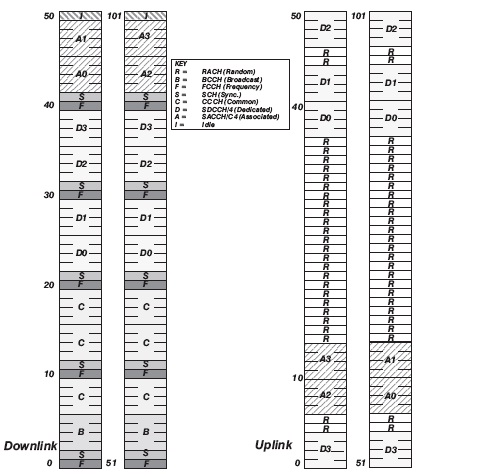How 26 and 51 Multiframes in GSM
GSM is very complicated when we talk about its rf side and in it very complicated to understand the structure of 26 and 51 Multiframes, here my try to make you understand simply.
The 26-frame Traffic Channel Multiframe in GSM
The Below Figure shows the time relationship between time-slot, GSM TDMA frame, and the 26-frame multiframe. Some of the times shown are approximate numbers as the GSM recommendations actually state the exact values as fractions rather than in decimal form (for example, the exact duration of a time-slot is 15/26 ms).
Note:
The 12th frame (no. 13) in the 26-frame traffic channel multiframe is used by the GSM Slow Associated Control Channel (SACCH) which carries link control information to and from the MS– to GSM BTS. Each timeslot in a cell allocated to traffic channel usage will follow this format, that is, 12 bursts of traffic, 1 burst of SACCH, 12 bursts of traffic and 1 idle.
The duration of a 26-frame traffic channel multiframe is 120 ms (26 TDMA frames). When half rate is used, each frame of the 26-frame traffic channel multiframe allocated for traffic will now carry two MS subscriber calls (the data rate for each MS is halved over the air interface). Although the data rate for traffic is halved, each MS still requires the same amount of SACCH information to be transmitted, therefore frame 12 WILL BE USED as GSM SACCH for one half of the MSs and the others will use it as their IDLE frame, and the same applies for frame 25, this will be used by the MSs for GSM SACCH (those who used frame 12 as IDLE) and the other half will use it as their IDLE frame.
The 51-frame Control Channel Multiframe in GSM
The 51-frame structure used for control channels is considerably more complex than the 26-frame structure used for the traffic channels. The 51-frame structure occurs in several forms, depending on the type of control channel and the network provider’s requirements.
The 51-frame Control Channel Multiframe (BCCH/CCCH)
The BCCH/CCCH 51-frame structure a shown below will apply to timeslot 0 of each TDMA frame on the ‘BCCH carrier’ (the RF carrier frequency to which BCCH is assigned on a per cell basis). In the diagram, each vertical step represents one repetition of the timeslot (= one TDMA frame), with the first repetition (numbered 0) at the bottom.
Looking at the uplink (MS–BSS) direction, all timeslot 0s are allocated to RACH. This is fairly obvious because RACH is the only control channel in the BCCH/CCCH group which works in the uplink direction. In the downlink direction (BSS–MS), the arrangement is more interesting. Starting at frame 0 of the 51-frame structure, the first timeslot 0 is occupied by a frequency burst (‘F’ in the diagram), the second by a synchronizing burst (‘S’) and then the following four repetitions of timeslot 0 by BCCH data (B) in frames 2–5.
The following four repetitions of timeslot 0 in frames 6–9 are allocated to CCCH traffic (C), that is, to either PCH (mobile paging channel) or AGCH (access grant channel). Then follows, in timeslot 0 of frames 10 and 11, a repeat of the frequency and synchronising bursts (F and S), four further CCCH bursts (C) and so on. Note that the last timeslot 0 in the sequence (the fifty-first frame – frame 50) is idle.
The 51-frame Control Channel Multiframe – DCCH/8 (SDCCH and SACCH)
The diagram below shows the 51-frame structure used to accommodate eight SDCCHs, although, as it takes two repetitions of the multiframe to complete the entire sequence, it may be more logical to think of it as a 102-frame structure. This structure may be transmitted on any timeslot.
Note that the SACCHs (shaded) are associated with the SDCCHs. It is important to remember that each SDCCH has an SACCH just like a traffic channel.
i.e. D0 associated with A0
D1 associated with A1
. …..
D7 associated with A7
Note: The downlink and uplink channels are staggered in order to give the mobile time to process the received message and formulate a response.
The 51-frame Control Channel Multiframe – Combined Structure
As we can see in the diagram below, each of the control channel types are present on a single timeslot. The number of MSs which can effectively use this cell is therefore reduced, as we now only have 3 CCCH groups and 4 SDCCHs, which translates into fewer pages and simultaneous cell setups.
A typical use of this type of control channel timeslot is in rural areas, where the subscriber density is low.




